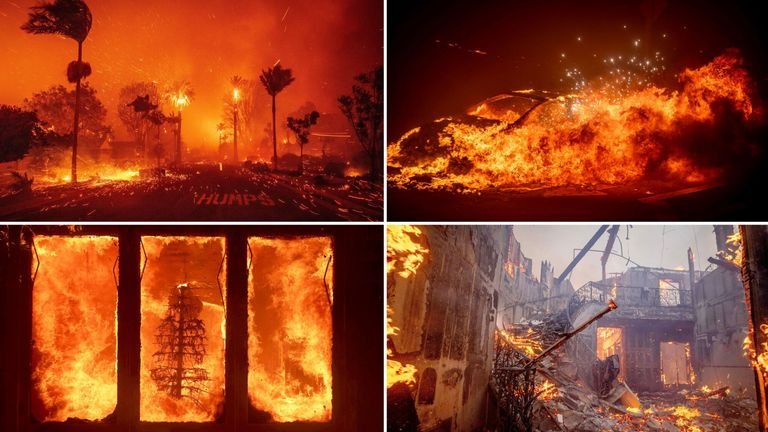Los Angeles: California Governor Gavin Newsom is under intense scrutiny following the devastating wildfires in Los Angeles that have razed over 10,000 buildings, claimed at least ten lives, and displaced thousands of residents. The inferno, which has been raging since Tuesday, has reignited criticism over Newsom’s decision to cut over USD 100 million in funding for forest resilience and wildfire prevention in the 2024–25 state budget.
The budget cuts, approved in June 2024, reduced allocations across seven critical programs aimed at mitigating wildfire risks. The Legislative Analyst’s Office estimates that these reductions, amounting to USD 101 million, impacted CAL FIRE fuel reduction teams, state conservancies, and forest management initiatives.
Breakdown of the Cuts
The reductions targeted key programs that play vital roles in wildfire prevention and management:
- Fuel Reduction Teams: A USD 5 million cut affecting California National Guard vegetation control efforts.
- State Conservancies: A USD 28 million reduction in funds meant to bolster wildfire resistance.
- Home Hardening Program: USD 12 million slashed from a trial initiative designed to protect homes from wildfires.
- Monitoring and Research: USD 8 million cut from CAL FIRE and state college programs focused on wildfire research.
- Forest Legacy Program: A USD 4 million reduction affecting landowner management methods.
- Inter-Agency Forest Data Hub: USD 3 million cut from this initiative, which facilitates cross-agency data sharing for forest management.
Criticism and Political Fallout
The wildfire crisis has fueled bipartisan criticism of Governor Newsom. Former President Donald Trump and other prominent Republicans have publicly denounced Newsom’s budget choices, with Trump taking to his Truth Social platform to demand the governor’s resignation. Trump accused Newsom of neglecting water restoration efforts and failing to prioritize wildfire prevention.
Environmentalists and public safety advocates have also expressed concern, arguing that the cuts undermine California’s preparedness for increasingly frequent and severe wildfires, driven by climate change.
Newsom’s Defense
In response, a spokesperson for Governor Newsom defended his record on wildfire management, highlighting significant investments during his tenure. According to the spokesperson, CAL FIRE’s budget has nearly quadrupled since Newsom took office in 2019, reaching USD 3.8 billion for 2024–25. Additionally, CAL FIRE’s workforce has grown substantially, from 5,829 personnel in 2019 to 10,741 in 2024.

“While difficult decisions had to be made to balance the state’s budget, Governor Newsom’s administration has consistently prioritized wildfire response and resilience,” the spokesperson stated.
Contradictory Trends in Wildfire Spending
Despite the recent cuts, CAL FIRE’s overall budget has seen a substantial increase under Newsom’s leadership—from USD 1.1 billion in 2014 to USD 3 billion in 2023. This has raised questions about the rationale behind the latest reductions, especially in the face of mounting evidence that wildfire risks are escalating across the state.
The Human Cost
As firefighters battle the Los Angeles blaze, the human toll is becoming increasingly apparent. Thousands of residents have been evacuated, and emergency shelters are overwhelmed. The destruction of homes, businesses, and infrastructure underscores the critical need for robust wildfire prevention and response strategies.
The Los Angeles wildfire has intensified the debate over California’s approach to wildfire management and resource allocation. As the state grapples with the immediate crisis, the long-term implications of the budget cuts will likely remain a contentious issue in Sacramento and beyond.
Governor Newsom, now facing a public relations crisis, will need to navigate growing political and public pressure while addressing the urgent needs of affected communities. Whether his administration’s wildfire strategy can withstand the scrutiny remains to be seen.





